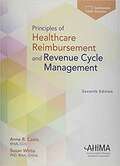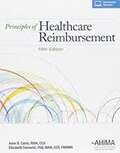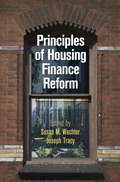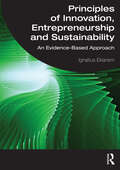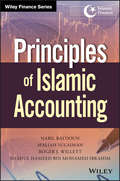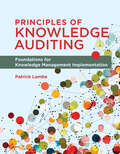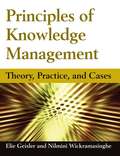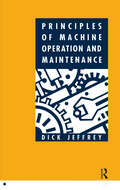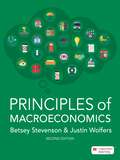- Table View
- List View
Principles of Healthcare Reimbursement
by Anne CastoPrinciples of Healthcare Reimbursement integrates information about all US healthcare payment systems into one authoritative resource. Boost your understanding of the complex financial systems in today's healthcare environment, including the basics of health insurance, public funding programs, managed care contracting, and how services are paid. Gain clear insight into how reimbursement systems have made an impace on providers and payers, consumers, public policy makers, and the development of classification and information technology systems over the years.
Principles of Healthcare Reimbursement
by Anne CastoPrinciples of Healthcare Reimbursement 7th Edition
Principles of Healthcare Reimbursement, Fifth Edition
by Elizabeth Forrestal Anne B. CastoThe fifth edition of Principles of Healthcare Reimbursement provides educators, students, and practitioners with up-to-date information on healthcare payment systems and their effects on the US healthcare delivery system and economy in one authoritative source.
Principles of Horticulture
by Charles Adams Jane Brook David Francis Mike EarlyGardening and horticulture generally are essentially practical activities much enhanced by an understanding of how plants grow. This colourful guide will introduce you to the fundamentals of horticulture. It is written in a clear and accessible style and covers the principles that underpin growing plants for the garden and allotment, with reference to how these are tackled by professionals.With highlighted definitions, key points and illustrations in full colour, this book will be a useful companion as you progress in the study and practice of horticulture. The book covers topics such as classifying and naming plants, the plant life cycle, ecology and garden wildlife, soils, composts, hydroponics, weeds, plant nutrition, plant pests, and plant diseases and disorders. The new edition has been updated to reflect changes in legislation and the modernization of horticultural practices. It is also fully reflective of the changes in the new syllabuses for horticulture at Level 2.Principles of Horticulture is a valuable resource whether you are taking a Level 2 RHS, City and Guilds, Teagasc or SNQ course, or are a keen amateur or seasoned gardener.The book is accompanied by ancillary materials including essential and extended information on horticultural principles and downloadable instructor resources.
Principles of Horticulture: Level 3
by Charles Adams Mike Early Jane Brook Katherine BamfordThis colourful guide will explain the fundamentals of growing plants, whether you are taking a Level 3 RHS, City and Guilds or Edexcel course, are a grower or gardener in the industry, or are just a keen amateur. Written in a clear and accessible style, this book covers the principles that underpin plant production, the use of growing media and crop protection, but with reference also to the same practices in the garden or allotment. With highlighted definitions, key points, and illustrated in full colour, this book will be a useful companion as you progress in the study and practice of horticulture. Complete with a companion website which includes extended horticultural information, questions and exercises to test your knowledge, syllabus cross-referencing and downloadable tutor and student support materials.
Principles of Housing Finance Reform
by Susan M. Wachter Joseph TracyIn the fall of 2008, the world watched in horror as the U.S. housing finance system shattered, triggering a global financial panic and ultimately the Great Recession. Now, nearly a decade later, the long and slow housing recovery has reached a critical moment. Though the housing finance system has stabilized, it remains in the hands of the federal government, leaving taxpayers exposed to the credit risk while private funding remains mostly on the sidelines.Principles of Housing Finance Reform identifies the changes necessary to modernize the housing finance system, identifying guiding principles that should underlie a rebuilt system. Contributors to the volume set out a wealth of innovative solutions that are possible within this framework, presenting proposals for long-term structural reforms that would infuse new life into the U.S. housing finance system while enhancing long-term stability.Nearly a decade after the inception of the Great Recession, reform proposals have arisen across the political spectrum. This is a moment of opportunity for rebuilding a key sector of the U.S. economy. The research in this volume represents the best thinking of policy researchers and economic experts on the challenges that lie ahead and provides a roadmap for reforms to create a system characterized by liquidity, stability, access, and sustainability.Contributors: W. Scott Frame, Meghan Grant, John Griffith, Diana Hancock, Stephanie Heller, Akash Kanojia, Patricia C. Mosser, Kevin A. Park, Wayne Passmore, Roberto G. Quercia, David Scharfstein, Phillip Swagel, Joseph Tracy, Susan M. Wachter, Dale A. Whitman, Mark A. Willis, Joshua Wright.
Principles of Innovation, Entrepreneurship and Sustainability: An Evidence-Based Approach
by Ignatius EkanemThis book presents the principles governing the entrepreneurial and innovation mindset and processes of people working in the small business sector and other organisations, based on research findings from real-life issues and challenges that face entrepreneurs on a daily basis. Entrepreneurship development forms the bedrock of business evolution and economic growth in many nations: indeed, without entrepreneurship, there can be no real economic development. This book provides students with an accessible introduction to innovation and entrepreneurship, examining the different forms of innovative and entrepreneurial practice including commercial and social enterprise. The book introduces some of the major business management issues faced by entrepreneurs and small business owners. It also introduces readers to such concepts as opportunity recognition and the ability to act upon opportunities and problem solving. Throughout, the book is founded on an evidence base drawn from the author's own years of teaching and research. An essential read for students of entrepreneurship and innovation at both undergraduate and postgraduate levels, Principles of Innovation, Entrepreneurship and Sustainability: An Evidence-Based Approach is an invaluable resource for anyone seeking to understand the realities of innovation and entrepreneurship in a more empirical context. Featuring a comprehensive range of case studies, reading lists, glossaries and discussion questions, this book provides students with all they need to develop their understanding of these exciting topics. The book is accompanied by digital learning resources including PowerPoint slides and test questions, complete with answers, for all chapters.
Principles of Institutional and Evolutionary Political Economy: Applied to Current World Problems (Springer Texts in Business and Economics)
by Phillip Anthony O’HaraThis is the very first book to explicitly both detail the core general principles of institutional and evolutionary political economy and also apply the principles to current world problems such as the coronavirus crisis, climate change, corruption, AI-Robotics, policy-governance, money and financial instability, terrorism, AIDS-HIV and the nurturance gap. No other book has ever detailed explicitly such core principles and concepts nor ever applied them explicitly to numerous current major problems. The core general principles and concepts in this book, which are outlined and detailed include historical specificity & evolution; hegemony & uneven development; circular & cumulative causation; heterogeneous groups & agents; contradiction & creative destruction; uncertainty; innovation; and policy & governance. This book details the nature of how these principles and concepts can be used to explain current critical issues and problems throughout the world. This book includes updated chapters that have won two journal research Article of the Year Awards on climate change (one from the European Association for Evolutionary Political Economy, EAEPE); as well as a Presidential address to the Association for Evolutionary Economics (AFEE) on corruption. The structure of the book starts with two chapters on the principles of institutional and evolutionary political economy: firstly their history, and secondly a chapter on the contemporary nature of the principles and concepts. This is followed by nine chapters applying some of the core principles to current world problems such as the coronacrisis, climate change, corruption, AI-robotics, policy, money & financial instability, terrorism, HIV-AIDS and the nurturance gap. The book finishes with a conclusion, a glossary of major terms and an index. The author’s principles are well established in the literature and this book provides a detailed exposition of them and their application.
Principles of Integrated Marketing Communications
by Lawrence AngPrinciples of Integrated Marketing Communications: A Focus on New Technologies and Advanced Theories explains the principles and practice of implementing an effective marketing strategy using a variety of channels and techniques, such as brand equity, advertising and personal selling. It equips students with the knowledge to develop sophisticated marketing campaigns for contemporary business environments. Designed to introduce students to IMC in an engaging way, this valuable resource covers the latest concepts and tools in marketing and communications - from theories of social influence to the growing use of social media. Each chapter contains a 'Further thinking' section, giving students the opportunity to extend their understanding of the conceptual and historical underpinnings of IMC and teaching them how to analyse and overcome problems when devising an IMC strategy. Each chapter also includes learning objectives and review questions, to reinforce knowledge. Extensive additional material - including extra case studies and topical multimedia files - is available on the companion website.
Principles of Integrated Marketing Communications: An Evidence-based Approach
by Lawrence AngMarketing in the digital age poses major challenges for traditional and established practices of communication. To help readers meet these challenges Principles of Integrated Marketing Communications: An Evidence-based Approach provides a comprehensive foundation to the principles and practices of integrated marketing communications (IMC). It examines a variety of traditional and digital channels used by professionals to create wide-reaching and effective campaigns that are adapted for the aims of their organisations. This edition has been thoroughly revised and each chapter includes: case studies of significant and award-winning campaigns from both Australian and international brands that illustrate the application of explored concepts; discussion and case study questions that enable readers to critically evaluate concepts and campaigns; a managerial application section that illustrates how concepts can be applied effectively in a real situation; a 'further thinking' section that expands knowledge of advanced concepts and challenges readers to think more broadly about IMC.
Principles of International Auditing and Assurance: 5th Edition
by Philip Wallage Rick HayesThis groundbreaking textbook redefines auditing education by seamlessly incorporating International Standards on Auditing (ISAs) and other IAASB assurance standards at its core, establishing a new paradigm in how auditing principles are taught. Recognized worldwide as the hallmark of auditing excellence, ISAs set the highest benchmarks for audit quality. This latest edition meticulously unfolds the evolution, application, and global integration of ISAs, alongside other assurance standards and key national frameworks, ensuring that the content remains at the forefront of international practices. It provides students with an extraordinary depth of insight into auditing and assurance, mirroring the very latest in contemporary practices and thought leadership. Key highlights:, Comprehensive exploration of the audit profession, essential concepts, the audit process across four stages, and specialized topics. Insight into the latest advancements in audit technology, including data analytics. Updates on the latest auditing and assurance standards, ensuring relevance and applicability. Expansion into a wide spectrum of assurance engagements, including a brand-new dedicated chapter on sustainability assurance. Practice questions styled like exams at the end of each chapter, facilitating effective review and learning. With its global perspective and adherence to the latest standards, this textbook is an essential resource for students aspiring to excel in the dynamic field of auditing.
Principles of International Finance (Routledge Library Editions: International Finance #3)
by Daniel R. KanePrinciples of International Finance, first published in 1988, provides a comprehensive introduction to international finance which is rapidly becoming an increasingly important branch of international economics. The book is structured so that it can easily be adopted as a complete one-semester course in international finance and is divided into the four major divisions of international finance: The Foreign Exchange Market and the Balance of Payments; Exchange Rate Systems; Equilibrium and the Adjustment Process and The Post-War International Financial System. This book is designed for economics and business undergraduates studying international finance for the first time. It is non-mathematical and presumes no more than a general background in macroeconomics.
Principles of Islamic Accounting (Wiley Finance)
by Roger Willett Nabil Baydoun Maliah Sulaiman Shahul IbrahimYour introduction to Islamic accounting Principles of Islamic Accounting is the first and only text that covers the fundamentals of Islamic accounting in English. A comprehensive guide, this groundbreaking reference offers both insight into Islamic accounting best practices and disclosure for Shariah-compliant instruments. Covering everything from basic transaction analysis to the preparation of financial statements, this reference serves as a broad framework around which undergraduate students can build their understanding of the Islamic business environment by offering context and showcasing how Islamic values can influence the disclosure of financial information. Islamic accounting is becoming an increasingly important aspect of the business field as globalization results in a surge in business partnerships and transactions around the world. Today's students need to understand Islamic accounting principles in order to effectively work with professionals who adhere to these standards—and accessing this information via text in English was not possible until this revolutionary reference. Review the basics through an introduction to Islamic accounting Understand the recording process, and how to complete the accounting cycle and adjust accounts as necessary Explore accounting for assets, liabilities, equity, and sukuk, as well as zakat and takaful accounting Discover details regarding Islamic commercial law, accounting for Islamic financial institutions, and Islamic corporate governance and sustainability, and look at auditing from an Islamic perspective Principles of Islamic Accounting is an essential text for first-year university students who are studying Islamic accounting, as well as professional societies and organizations that support the use of Islamic accounting principles, such as The Islamic Finance Professionals Association.
Principles of Knowledge Auditing: Foundations for Knowledge Management Implementation
by Patrick LambeA comprehensive theoretical and practical guide to the operating principles of knowledge auditing, illustrated with numerous case studies.A knowledge audit provides an &“at a glance&” view of an organization's needs and opportunities. Its purpose is to improve an organization's effectiveness through a better understanding of the dynamics and levers of knowledge production, access, and use. However, this developing field is hampered by the lack of a common language about the origins and nature of knowledge auditing. In Principles of Knowledge Auditing, Patrick Lambe integrates the theory and practices of the field, laying out principles and guidelines for a clearer and more pragmatic approach to knowledge auditing that makes it more accessible to practitioners and researchers.Lambe examines knowledge auditing in the context of the development of communications, information, and knowledge management in the twentieth century. He critiques and clarifies ambiguities in how knowledge audits are approached and described, as well as how the results are conveyed within organizations. He discusses the benefits and risks of knowledge management standards. Knowledge auditors, he says, need a common frame of reference more than they need standards. Standards have their uses, but they provide only markers and sign posts and are poor representations of the richness of the landscape. He concludes with a set of guiding principles for practitioners.
Principles of Knowledge Management: Theory, Practice, and Cases
by Nilmini Wickramasinghe Eliezer GeislerThis text provides a comprehensive introduction to the new field of knowledge management. It approaches the subject from a management rather than a highly technical point of view, and provides students with a state-of-the-art survey of KM and its implementation in diverse organizations. The text covers the nature of knowledge (tacit and explicit), the origins and units of organizational knowledge, and the evolution of knowledge management in contemporary society. It explores the implementation and utilization of knowledge management systems, and how to measure their impact, outputs, and benefits. The book includes a variety of original case studies that illustrate specific situations in which the absence or existence of knowledge management systems has been crucial to the organization's actions. Charts and figures throughout help clarify more complex phenomena and classifications, and each chapter includes review questions and a comprehensive index.
Principles of Machine Operation and Maintenance
by Dick JeffreyThis book explains how rotating machinery works, and the role of the maintenance engineer in ensuring its proper operation. Stress is laid on the need for the trainee engineer to develop skills in diagnosis and troubleshooting as well as practicalexpertise in maintenance procedures.
Principles of Macroeconomics
by Robert H. Frank Ben Bernanke Kate Antonovics Ori HeffetzPrinciples of Macroeconomics focuses on seven core principles to produce economic naturalists through active learning. By eliminating overwhelming detail and focusing on core principles, students from all backgrounds are able to gain a deeper understanding of economics. Focused on helping students become "economic naturalists," people who employ basic economic principles to understand and explain what they observe in the world around them. COVID-19 pandemic content, analysis, and examples further engage students. <p><p> With engaging questions, explanations, exercises and videos, the authors help students relate economic principles to a host of everyday experiences such as going to the ATM or purchasing airline tickets. Throughout this process, the authors encourage students to become "economic naturalists." Author developed Learning Glass concept overview videos and Worked Problem videos give students an overview of challenging and important concepts. <p><p> With new videos and engagement tools in Connect, like Application-Based Activities, alongside SmartBook's adaptive reading experience, the 8th edition enables instructors to spend class time engaging, facilitating, and answering questions instead of lecturing on the basics.
Principles of Macroeconomics
by Betsey Stevenson Justin WolfersStevenson/Wolfers is built around the idea that ‘every decision is an economic decision’. It is the perfect choice for Principles of Economics courses and for economics majors and nonmajors alike.
Principles of Macroeconomics
by Edwin MansfieldStudents will appreciate the accompanying Study Guide, prepared by Professor Mansfield himself. It contains Chapter Profiles, behavioral Objectives, Case Studies, Objective Questions, Discussion Questions, and Problems for each chapter in the textbook. A separate Computerized Study Guide with approximately 200 review questions and diagrams is also available.
Principles of Macroeconomics
by Justin WolfersBetsey Stevenson and Justin Wolfers present a new synthesis of economic principles for a new generation of students. Their focus on useful economics employs compelling explanations and real-life examples to help students develop economic intuition and apply it to everyday decisions. The authors provide a fresh take on a wide range of principles topics and develop macroeconomics from its microfoundations in an engaging presentation that has drawn enthusiastic reviews from hundreds of instructors and thousands of students in pre-publication class-tests. This text is available in Achieve, a new, integrated online learning system that features powerful tools for each step of the Learning Path: pre-class, in-class, and post-class.
Principles of Macroeconomics
by N. Gregory MankiwWith its clear and engaging writing style, PRINCIPLES OF MACROECONOMICS, Seventh Edition, continues to be one of the most popular books on economics available today. Mankiw emphasizes material that you are likely to find interesting about the economy (particularly if you are studying economics for the first time), including real-life scenarios, useful facts, and the many ways economic concepts play a role in the decisions you make every day.
Principles of Macroeconomics
by N. Gregory MankiwEconomics is fundamentally about understanding the world in which we live. Most chapters of this book include Case Studies illustrating how the principles of economics can be applied. In addition, In the News boxes offer excerpts from newspapers, magazines, and online news sources showing how economic ideas shed light on current issues facing society. After students finish their first course in economics, they should think about news stories from a new perspective and with greater insight.
Principles of Macroeconomics
by N. Gregory MankiwGain a strong foundation in macroeconomics with today's most popular economics text, trusted by students worldwide -- Mankiw's PRINCIPLES OF MACROECONOMICS, 10E. Using a clear, inviting writing style, this edition focuses exclusively on content to help you better understand the world and economy in which you live. You become a more astute participant in today's economic environment as you learn the potential and limits of economic policy. The latest examples and learning features bring macroeconomic principles to life as author Gregory Mankiw puts himself in the position of someone seeing economics for the first time. Dr. Mankiw's goal is to emphasize the material you will find most relevant and interesting as you study macroeconomics. MindTap digital resources, Aplia digital homework solution and author videos are also available to help you further master key macroeconomic principles.
Principles of Macroeconomics
by OpenStaxPrinciples of Macroeconomics covers the scope and sequence for a one-semester economics course. The text also includes many current examples, including: the housing bubble and housing crisis, Zimbabwe’s hyperinflation, global unemployment, and the appointment of the United States’ first female Federal Reserve chair, Janet Yellen. The pedagogical choices, chapter arrangements, and learning objective fulfillment were developed and vetted with feedback from educators dedicated to the project. The outcome is a balanced approach to economics, to both Keynesian and classical views, and to the theory and application of economics concepts. Current events are treated in a politically-balanced way, as well.
Principles of Macroeconomics
by Soumyen SikdarThis textbook introduces macroeconomics to students of economics and management who have limited exposure to the subject. It is a lucid and concise exposition of basic economic theory aided by numerical examples and simple diagrams.

